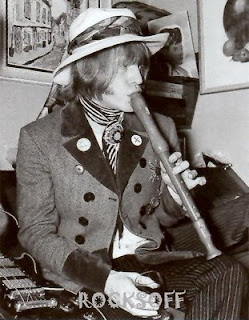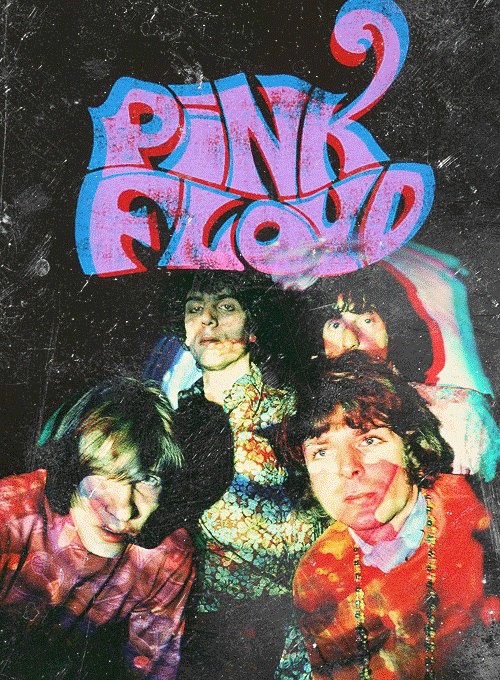Syd Barrett, September 1967
What can be said about Syd Barrett that hadn't been said already? His brief musical career as a lead singer/guitarist of Pink Floyd and solo artist, followed by acid-induced madness and withdrawal from the world still continues to fascinate and, over the years, he has been a subject of numerous books, articles and documentaries.
Syd in January 1967.
Syd with early girlfriend Lindsay Corner, 1967
As well as being an influential guitarist and songwriter, Barrett also deserves a credit as a style icon. In the spirit of the times, his look was very flamboyant - Paisley shirts, frilled shirts, satin or velvet trousers, double breasted jackets, cravats etc. Like many other London musicians at the time , Barrett was buying his psychedelic/peacock gear in King's Road boutiques.Some of his clothes were made to measure by designer Thea Porter. Julian Palacios wrote in his biography of Barrett: For Syd, the image tied in with his art, rather than simple vanity. The era demanded peacocks. Barrett stepped up and took on the role of a star (Julian Palacios, Dark Globe : Syd Barrett and Pink Floyd, p 205).
Pink Floyd, 1967
Pink Floyd, 1967
Syd in 1967
Barrett had a rare ability of pulling off nearly any outfit. It is visible in the photos of Pink Floyd circa 1967. Your eye is instantly drawn to Barrett, while his band mates look rather uncomfortable, or even ridiculous (just look at Roger Waters) in their psychedelic gear.
Pink Floyd, 1967: Nick Mason, Rick Wright, Roger Waters and Syd Barrett
Syd Barrett, 1967
1967
Syd and Roger Waters, 1967
Nick Mason, Syd Barrett and Rick Wright in De Lane Lea studio, October 1967
Pink Floyd performing at Top Of The Pops, 1967
Syd In July 1967
Syd in July 1967
Pink Floyd on tour in Denmark, 11.09.1967. Syd Barrett, Roger Waters, Nick Mason and Rick
Wright.
Syd with Roger Waters, 1967
Roger Waters and Syd Barrett, 1967
Syd Barrett, Rick Wright and Roger Waters, 1967
Where's Syd? - Pink Floyd on a package tour with Jimi Hendrix Experience, The Move and Amen Corner, November 1967.
Syd's girlfriend, Lindsay Corner was his sartorial advisor. Julian Palacios wrote:
As his star rose, Lindsay's sharp eye and expert combination of King's Road cool were crucial to his new look. Her keen eye made for inspired choices. With hair grown out his trendy Carnaby Street trousers and candy striped shirts sacrificed for velvet, satin, silk in red, lilac and green, and crimson. Syd and Lindsay took to the King's Road fashion scene with relish, migrating to Granny Takes a Trip, where Barrett was fitted for a satin outfit in green and red. Next was Gohil's leather Goods store in Camden, where the owner outlined Syd's feet for custom-made short ankle boots with elastic gussets.
With Lindsay, Barrett made the scene dressed in silk and velvet, in pied patches like medieval minstrels. Walking on King's Road on Saturdays, dressed in all their finery, the couple were splendid peacocks on parade. In a luminous dash, they prowled boutiques, piecing a unisex wardrobe mix of gypsy, aristocrat, harlequin and harlot (Julian Palacios, Dark Globe : Syd Barrett and Pink Floyd, p 205).
Following Lindsay Corner's advice, Syd also started using kohl eyeliner, which, combined with his black, messy hair made him a precursor of Gothic look. There is indeed a very Gothic feel to certain photographs of Syd Barrett and Pink Floyd.
Pink Floyd, 1967 (or is it The Cure in 1981?)
Pink Floyd , 1967
Pink Floyd , 1967
Pink Floyd , 1967
Syd Barrett with a friend Jenny Spires in July 1967.
1967
Syd Barrett's uncontrollable LSD intake was a cause of his increasingly erratic behavior which was a reason for his departure from Pink Floyd in early 1968. Despite his problems, he managed to record two great solo albums: "The Madcap Laughs" (1969) and "Barrett"(1971) - both produced by Dave Gilmour - Barrett's friend and his replacement in Pink Floyd.
Syd in 1969, during recording of "The Madcup Laughs".
1969
Syd Barrett photographed by Mick Rock, London 1969.
Syd Barrett posing for the photoshoot for a cover of "The Madcap Laughs". This photo was taken in Syd's flat in South Kensington by Mick Rock in 1969.
1969
Syd in 1971
After a last, unsuccessful visit to studio in 1974, Syd Barrett had vanished from public eye for good. He never came back to playing music, and from seventies onwards, he led a life of a recluse. He became one of the most enigmatic figures in popular music history. The interest in Barrett had increased after his death in July 2006. In 2010, two very extensive biographies of Barrett were published within two months of each other: Dark Globe : Syd Barrett and Pink Floyd by Julian Palacios and Very Irregular Head by Rob Chapman.


Although there are similarities between the two publications ( In both books, for example, chapters start with quotations from The Wind In The Willows by Kenneth Grahame - one of the biggest lyrical influences on Syd) they are surprisingly different. Rob Chapman makes rather unconvincing attempt to portray Barrett as a modern-day English Romantic. He spends a lot of time doing pseudo-academic analysis of Syd's lyrics, and devotes a lot of too much space to his literary influences. There is surprisingly little about his musical influences - his teenage love of blues and R'n'B hardly gets mentioned, neither does the fact that he abandoned blues in order to venture into more experimental fields. Chapman fails to remember that Barrett was, above all, a rocker. His innovative ways of playing guitar were more influential than his work as lyricist.As Julian Palancios notices in his, much better book, Barrett was one of the few iconic 60's musicians whose work was embraced post-punk musicians of late 70's. For that generation of musicians who sought to play a guitar music that is not based on blues, Syd's work was a big influence. Public Image Ltd, Echo and The Bunnymen, Jesus and Mary Chain, Siouxsie and The Banshees, The Cure (Robert Smith's look seemed to be also partly inspired by Barrett) - all of those acts spoke of their love of Syd Barret and early Pink Floyd (while the 1970's incarnation of Pink Floyd represented everything they stood against).
In Dark Globe : Syd Barrett and Pink Floyd Julian Palacios also makes a very interesting account of London underground psychedelic scene between 1966 and 1967 - a parallel story which is almost as fascinating as the story of Syd. I throughly recommend Julian Palacios's book as the best one ever written on the subject of Syd Barrett.




























































